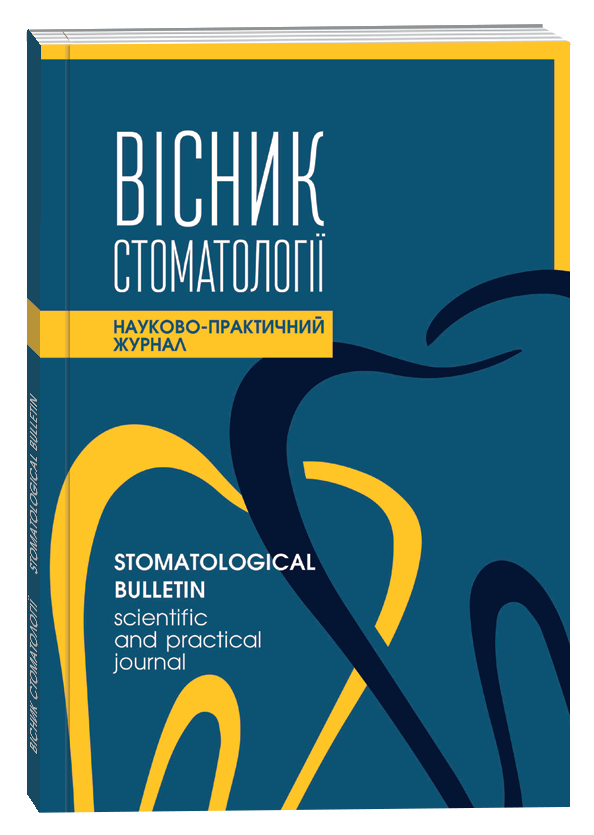PREVALENCE AND INTENSITY OF EARLY CHILDREN'S CARIES IN CHILDREN OF BUKOVINA
DOI:
https://doi.org/10.35220/2078-8916-2021-40-2.11Keywords:
early childhood caries, prevalence, intensity, caries localizationAbstract
Goal. To study the prevalence and intensity of early childhood caries in children of Bukovina. Materials and methods. 349 children aged 1 to 3 who were born and lived in Chernivtsi were examined. In all children, the caries indices of dmf and dsmsf were determined, according to which the prevalence and intensity of the disease were assessed. The level of intensity was determined by a modified and adapted to early childhood LICrt index (Bidenko NV, 2012). Scientific novelty. There has been an increase in the incidence of early childhood caries with increasing age of children, in particular, at the age of 1-2 years, almost one of five children had lesions of the hard tissues of the teeth. In children older than one year, the incidence increased 1.9 times, and at the age of 3-4 years 2.4 times and was assessed as high according to WHO criteria. The intensity of caries of temporary teeth in children also increased with age and was probably different in children of different age groups. During examinations of children, we recorded complications of caries. The percentage of children aged 1-2 years was 2.0%, 6.43% – in 2-3 years and 13.21% - in 3-4 years. Analysis of the location of carious cavities on the jaws and groups of teeth showed that in children aged 1-2 years the localization of the lesion on the frontal upper teeth is dominant. The second place in the frequency of lesions is occupied by the first temporary molar, which is primarily affected on the lower jaw, and then on the upper. In those examined at the age of 2-3 years, the percentage of lesions of the first temporary molars increases to 34.01%, while maintaining the tendency to the predominance of mandibular teeth, and the lesions of the second temporary molars are diagnosed for the first time.For children aged 3-4, the most affected tooth is the lower first temporary molar, followed by the upper frontal teeth, then the lower second molar and the upper first molar and the canines of the upper jaw. Conclusions. The prevalence and intensity of early childhood caries in children living in Chernivtsi are high, tend to increase with age, especially a sharp jump in the incidence is detected at the age of 2 years, which should be taken into account when developing a disease prevention system.
References
World Health Organization, 2017 ЕСС. URL : https://apps.who.int/iris/bitstream/handle/10665/255627/WHO-NMH-PND-17.1-eng.pdf?sequence=1.
Alazmah A. Early Childhood Caries: A Review. The Journal of Contemporary Dental Practice. 2017 Aug; 18(8): 732–7.
Ramos-Gomez F. Early Childhood Caries: Policy and Prevention. Journal of South Asian Association of Pediatric Dentistry. 2020 Jun; 3(1): 3–6.
Javed F, Feng C, Kopycka-Kedzierawski D.T. Incidence of early childhood caries: A systematic review and meta-analysis. J Invest Clin Dent. 2017 Nov; 8(4) : e12238.
Folayan M.O., El Tantawi M., Ramos-Gomez F., Sabbah W. Editorial: Country Profile of the Epidemiology and Clinical Management of Early Childhood Caries. Front Public Health. 2020 Apr 30; 8:141.
Каськова Л.Ф., Янко Н.В. Профілактика карієсу тимчасових зубів. Полтава : ТОВ НВП «Укрпромторгсервіс», 2017. 75 с.
Якубова І.І. Вплив аліментарного чинника в антенатальний і постнатальний періоди на виникнення карієсу тимчасових зубів у дітей та його профілактика (клініко-експериментальне дослідження) : автореф. дис. … д-ра мед. Наук : 14.01.22. НМАПО імені П.Л. Шупика МОЗ України. Київ. 2013. 31 с.
Біденко Н. Патогенез, клінічна картина, прогнозування, особливості лікування і профілактики карієсу зубів у дітей віком до 3-х років : автореф. дис. … д-ра мед. Наук : 14.01.22. Київ, 2012. 35 с.









